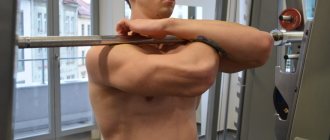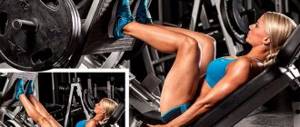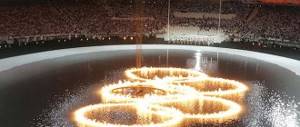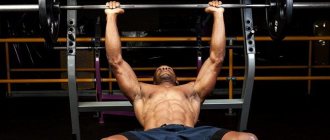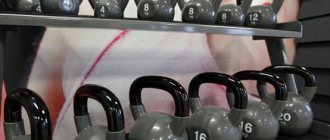November 28, 2021 Admin Home page » Nuances of the training
Why are warm-up approaches necessary? Execution rules. When to do it. Examples of warm-up approaches.
Many trainees automatically perform warm-up approaches based on the concept of how it should be, but how to do it correctly and when exactly, the answer to the question is difficult. To make it immediately clear, let's move on to the simplest example.
You can bench press 100 kg. just 1 time, then the working weight fluctuates within 80 kg. for 6 reps. This means the warm-up approach should start with 50 kg. (but before that it is recommended to perform 15-20 repetitions simply with an empty bar).
However, if with a weight of 50 kg. do 20 repetitions, then the warm-up will develop into a full-fledged load, which is dangerous for muscles that have not warmed up without sufficient elasticity. Therefore, it is necessary to perform a maximum of 8-10 repetitions, which will be the real warm-up set.
If you plan to lift the maximum weight, for example, for 1-2 repetitions, then after warming up with an empty bar and the same 50 kg, you can additionally press the barbell 80 kg. only for 1-2 repetitions.
What is a warm-up approach?
A warm-up set is a set performed for a number of repetitions SIGNIFICANTLY below the maximum.
For example, you bench press 100 kg for 1 rep, and let your working weight be 80 kg for 6 reps. Then let your warm-up approach be 50 kg. BUT! If you take 50 kg and press 20 times, then this will not be a warm-up approach, since when you press 80 kg for 6 - 50 kg for 20, this is quite a large load and it’s unlikely that you can squeeze 50 kg for much more than 20 repetitions. But if you press these 50 kg for 10 repetitions or less, then this will already be a warm-up approach.
Second option: you took 80 kg and pressed not 6 times (your maximum), but 1 - 2 times. This will also be a warm-up approach, despite the fact that the weight was working. As a rule, such warm-up approaches are needed only when the athlete is planning to lift maximum weights.
Why follow the rules
Sets and repetitions are an important part of training.
In order to increase the effectiveness of training and achieve certain results, the entire training process is divided into rest and work. Each muscle needs to be worked several times, giving it time to rest. Such cycling is necessary for the muscles to work as efficiently as possible.
If you just take a barbell and do the maximum number of repetitions, it will not bring much effect. Endurance and strength will increase too slowly from such an ineffective waste of the body's physical resources.
If you do, for example, 10 repetitions and move on to the next exercise, there will be no progress either. The only thing you will get is a “preventive” load on the muscles.
This approach is only useful if you do exercises in the morning.
The goal of this method of doing exercises is to maintain the muscular and circulatory system in a normal state and nothing more.
But the most effective option is to first load the muscle, then give it a rest, repeat this until the desired degree of depletion of its resource. The rest period should allow the muscle to restore its energy reserves for further work.
However, if this interval exceeds the time after which the muscle begins to “cool down,” such a break can lead to injury. Typically the rest lasts from 30 seconds to 4-5 minutes.
We’ll tell you later how to individually choose this time for you.
Thus, sets and repetitions are needed to achieve the best results from your training. The reps and sets you perform depend on your training goals and training weights accordingly.
There is a completely natural logic here: the higher the working weight, the fewer repetitions you can do with it. That's not all: the heavier the weight, the longer you need to rest before doing the next set.
Why are warm-up approaches needed?
1. Reduces the risk of injury. This occurs due to warming up and stretching of joints and muscles under a small, but still load.
2. Increasing the effectiveness of working approaches. The fact is that after warm-up approaches, muscles are able to develop greater strength, since they are better stretched and better filled with blood.
3. Improving exercise technique. This point is relevant mainly for beginners. With a small weight it is easier to learn and consolidate the exercise technique.
When does warm-up help increase results?
Once again, the main purpose of warming up is to increase blood flow to the muscle fibers and warm them up. As for athletic performance, well-warmed muscles show better results when trying to lift maximum weights.
In other words, at submaximal loads, you will feel virtually no effect from the warm-up. However, when you are trying to lift a record weight, warm-up sets play a significant role.
When attempting a one-rep max, we have to give it our all. That is, we are trying to lift the maximum weight at one time. In this case, the muscles must give 100%.
One study with cyclists noted that maximum muscle power increased by 2% with a 2°C increase in temperature. And when operating at maximum speed, power increased by 10%. In short, the more intense the exercise, the greater the role muscle temperature plays. Naturally, no one comes to the gym and immediately tries to do a maximum chest press or squat with a maximum weight. It's just common sense.
Still, if you are trying to lift maximum weight, then warm-up sets will play a vital role.
Rules for performing warm-up approaches
1. The first warm-up set (even if it is the last) should be with a weight of NO MORE than 50% of your one-rep maximum. That is, if you bench press 100 kg for 1 rep, then the first warm-up should be a MAXIMUM of 50 kg.
2. Warm-up approaches should be done immediately before a particular exercise, and not in bulk at the beginning of the workout. The exception is the circular method. There you need to do warm-ups en masse at the beginning. BUT! In the circular method, as a rule, the weights on the equipment are small.
3. The technique for performing warm-up approaches should be the same as for workers. That is, it is a bad idea to squat with a wide stance during the warm-up, and with a narrow stance during the working approaches.
4. Rest after warm-up approaches should be 1.5 - 2 times less than after work sets. For example, if after work you rest for 2 minutes, then 1 – 1.5 minutes of rest is enough.
5. Number of repetitions. There are no exact numbers here, but I voiced the basic rule at the beginning: the number of repetitions should be significantly lower than the maximum. Typically, the lighter the weight, the more repetitions. And as you approach the working weights, the number of repetitions decreases. On average this is 8 – 12 repetitions. However, in warm-up sets the number of repetitions may well be less than in working sets. This is usually observed in more trained people.
Sarcoplasmic hypertrophy
Sarcoplasmic hypertrophy results in an increase in the amount of sarcoplasm in your muscle tissue. Sarcoplasm is the cytoplasm (nutrient fluid) that surrounds the myofibrils in the muscle fiber. Sarcoplasm contains substrates such as ATP, glycogen, creatine phosphate and water. In simple terms, when you work on sarcoplasmic hypertrophy, the amount of fluid in the muscles increases significantly, creating greater muscle volume.
This type of hypertrophy develops through slow, controlled movements to place muscles under longer stress and activate both types of muscle fibers while depleting energy substrates.
Note that an increase in muscle size does not require an increase in the contractile muscle proteins in the myofibrils (read: myofibrillar hypertrophy), meaning that an increase in size is not necessarily associated with an increase in strength. At the same time, strength can be significantly increased without noticeable gains in muscle mass.{banner_st-d-1}
How should I train to develop these types of hypertrophy?
Neuromuscular training increases the activation of muscle fibers by the nervous system, as well as the amount of contractile proteins in the myofibrils. These workouts are based on heavy weights (85-100% of your 1RM) and consist of fast, explosive movements for 1 to 40 seconds per set. Rest periods between sets can vary from 90 seconds to 5 minutes.
Metabolic training is based on increasing the amount of energy substrates in muscle fibers. The important thing here is to use medium weights (60-75% of your 1RM), perform the exercises slowly and keep the muscle under load for 40-70 seconds. Rest time is recommended from 30 to 60 seconds.
You may notice that there is a gap of 10% of 1RM between these types of training. This is because in this interval both indicators develop best at once, i.e. and strength and muscle volume.
— How can I determine my 1RM and relative percentages of 1RM?
Fortunately, we have many options to calculate it easily. The calculator website below will help you calculate the percentages based on your current reps/weight of the exercises.
— How can I determine the time under load for optimal myofibrillar/sarcoplasmic hypertrophy?
The easiest way to help you is to stick to a specific rep pattern. Typically, when you perform low reps per set, your muscles will be under load for a short time and the weights will be close to maximum (and therefore will build strength through neuromuscular training). On the other hand, when you finish a set with high reps, your muscles will have more time under tension and the weights will be quite light compared to the max. This will increase your training volume and, as a result, your muscle size through this type of training. It is recommended to rest for no more than 60 seconds.
Below is a list of reps you can use to change the focus of your workouts:
• 1-5 repetitions 85-100% More myofibrillar training, closer to 5 repetitions – a small increase in sarcoplasm.
• 6-8 Reps 75-85% Golden mean. Almost identical development of both myofibrillar hypertrophy and sarcoplasmic hypertrophy.
• 9-12 Reps 70-75 More sarcoplasmic training, a little myofibrillar and weak on endurance.
• 13-15 Reps 65-70% Almost only sarcoplasmic, little endurance and very weak effect on myofibril hypertrophy.
• 15+ Reps* 65% More endurance, lots of sarcoplasmic hypertrophy.
*Note that the more you increase the number of repetitions after 15, the more your workouts become endurance training and hypertrophy fades away.
When should you do warm-up sets?
There is no answer to this question. Everyone decides for themselves in each individual case. I can only say that it depends on:
1. Your fitness level. As a rule, the higher it is, the fewer warm-up approaches there may be, or sometimes they are not needed at all (all other things being equal). More often than not, this is true, but not always.
2. Projectile weights. For example, it's obvious that if you're squatting 300kg, you'll need more warm-up sets than someone squatting 70kg. And if you are a beginner and are going to squat with an empty bar, then why do you need a warm-up approach at all?
3. Injuries and pain. If you are going to do an exercise that causes joint pain, then you may need a warm-up approach even where no one ever does it.
4. The exercise itself. The more basic the exercise, the greater the need for a warm-up approach. For example, with barbell squats, almost everyone needs a warm-up set (or several). But when extending the legs in the simulator, most people do not need a warm-up approach. It also depends on the risk of injury of the exercise. For example, lying dumbbell flyes are an isolating exercise, but quite dangerous. Therefore, in most cases it requires a warm-up.
5. Previous exercises. For example, if you do the leg press as your very first leg exercise, you'll likely need a warm-up set (or several). But if you have already squatted with a barbell before the leg press, then your muscles and joints on your legs have already warmed up and in this case, a warm-up may no longer be necessary.
Ultimately, the need to warm up depends on the combination of all these factors. That is, for example, it does not mean that a warm-up is not needed in all isolating exercises, but that it is necessary in all basic exercises. You need to look at all these 5 factors and decide on the amount.
In this case, the number of warm-up approaches can be from one to infinity. This is influenced by exactly the same factors that I just cited. But, as a rule, 1 or 2 such approaches are enough for amateurs. Less often - 3.
How many repetitions do you need?
If you are a beginner (poor shape and no training experience, plus, possibly, extra pounds)
Do simple bodyweight exercises for 15 or more repetitions. Try to increase this number to 40-50 or more. Examples of exercises: squats, push-ups from the knees, twisting, bending forward, pull-ups on a low bar, etc.
If you are a beginner (training for less than 3-6 months)
Perform strength exercises for 12-15 repetitions. Try to gradually increase your working weight.
If you have an average level of training (train for 6 to 12 months)
You should think about periodizing your training. This is a simple alternation of sets of exercises with different numbers of repetitions. You will definitely benefit from 6-8, 12-15, and 15-25 repetitions. And it would be better to divide them into different sets of exercises performed in different months of the year.
I can recommend this to all experienced people. But the range of repetitions for you is even wider - from 1 to 50 in different programs throughout the year.
If you have extra pounds (but are at least somewhat mobile)
Start practicing high-repetition simple bodyweight exercises. Do 20-40 or more squats per set. Do a lot of inclines (20 or more per set). It is this method that has proven itself perfectly in my training Drying for the Smart.
If you are underweight or are an ectomorph (and already have at least 3 months of training experience)
Do sets of 4-6 or 6-8 reps. This will allow you to grow muscles and gain weight as quickly as possible. No amount of push-ups or running will help here. What you need is strength training and a very nutritious diet. And rest more between sets. The workout will be longer, but the “meat” will grow effectively.
If you are over 50 years old
It is recommended not to use low repetitions (1-6) in training. More precisely, use it rarely, as peak training once every 2-4 weeks. However, you shouldn’t give up strength training altogether. Over the course of a year, you should have 2-3 complexes for 1-2 months with the number of repetitions from 6 to 10. This is extremely important precisely because of age, when muscle mass is actively lost, and with it the remnants of health.
I wish you successful studies! Questions and comments are welcome.
Squats: 12 Best Options for Every Occasion Burpee. What is it and why is it needed. Exercises for home. 15 best exercises for home workouts.
Examples of my warm-up hikes
I was going to bench press the maximum weight today (140 - 150 kg). I do this: 50 kg x 10. 80 kg x 8. 110 kg x 5. 130 kg x 2. These were all warm-up approaches. And then I do working sets of 140 - 150 kg for 3 - 1 repetition.
I was going to do 200 kg deadlift for 6 reps 4 sets. Warming up: 70 kg x 6. 120 kg x 6. 170 kg x 6.
I was going to bench press 70 kg for 8-10 reps. In this case, only 1 warm-up approach is enough for me: 50 kg x 6-8 times.
If I’m training my legs, and the first thing I do is squats with a barbell, then the leg press, and then lunges with a barbell, then I can easily do a warm-up ONLY with squats, and start leg presses and lunges immediately with working weights, since my legs Already warmed up well after squatting. But I have a lot of experience, and for many beginners this may not be suitable.
For standing barbell curls, I only do a warm-up set if the working weight is more than 50 kg, or if this is the first exercise in the workout. In all other cases I do without warming up.
I ALWAYS do a warm-up set for dips because I have shoulder pain.
Program in the hall for men for 4 days
The gym gives us every opportunity to train with maximum efficiency and comfort while burning fat. We have all the necessary equipment at hand. There is no need to reinvent the wheel, just do basic, isolated and, if necessary, cardio exercise. For the soul, you can add something more functional. It is advisable to train with an experienced partner who will help complicate the training by helping with forced repetitions or providing insurance when working with heavy weights. The productivity of the training will only increase from this.
The terrain training program for men below includes 4 workouts per week. Each session lasts approximately 1-2 hours. This complex is suitable for athletes who already have extensive training experience. The program for beginners will be presented below.
| Exercise name | Number of approaches and repetitions | Photo |
| Monday (chest + triceps) | ||
| Bench press | 4x10 | |
| Incline Dumbbell Press | 3x10 |
|
| Dips | 3x10-12 | |
| Incline Dumbbell Flyes | 3x12-15 |
|
| Crossover | 3x12-15 |
|
| French bench press | 3x12 | |
| Triceps extension with cable handle | 3x12-15 |
|
| Wednesday (back + biceps) | ||
| Wide grip pull-ups | 4x10-12 | |
| Bent-over barbell row | 4x10 |
|
| Close-grip lat pull-down | 3x10 |
|
| Horizontal block pull | 3x10 |
|
| Hyperextension | 4x12-15 |
|
| Incline Dumbbell Curls | 3x10-12 |
|
| Arm curls on a block with a rope handle | 3x12-15 |
|
| Friday (shoulders) | ||
| Seated dumbbell press | 4x10-12 |
|
| Shoulder press | 3x12 |
|
| Wide grip barbell row | 4x12 |
|
| Swing dumbbells to the sides | 3x12-15 |
|
| Abductions for the rear delta in the butterfly simulator | 3x12-15 |
|
| Leads to the rear delta in a crossover from the upper handles | 3x12-15 |
|
| Crunches in the simulator | 4x12-15 | |
| Saturday (legs) | ||
| Leg extensions in the simulator | 2x15-20, warm-up |
|
| Squats | 4x10-12 |
|
| Leg press | 3x10-12 | |
| Leg extensions in the simulator | 3x12-15 | © Makatserchyk — stock.adobe.com |
| Deadlift on straight legs | 4x10 | |
| Leg curls in the simulator | 4x12-15 |
|
| Standing calf raises in the machine | 4x12-15 |
|
| Hanging Leg Raises | 4x10-15 | |
You also need to add cardio training. Their quantity depends on the stage of drying and the amount of excess fat. You can start with three workouts a week, doing cardio in the morning or after strength training for 30-40 minutes. Closer to competitions, athletes can perform daily aerobic exercise for an hour or more. Choose the duration and quantity of these workouts individually based on your fitness and form.
As for the type of cardio, most perform low-intensity monotonous work with a heart rate of 60-70% of the maximum. Another good option is shorter interval training, which alternates periods of high intensity with a heart rate of 80-95% of maximum and periods of low intensity or rest with a heart rate of 40-60%. Many studies show interval training to be more effective.



